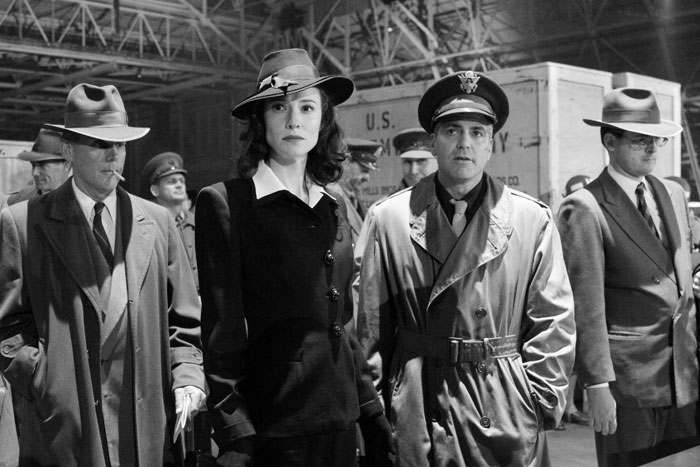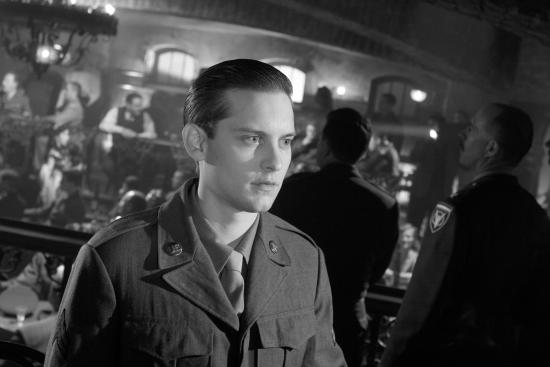The Good German (2006)
DIRECTOR: Steven Soderbergh
CAST:
George Clooney, Cate Blanchett, Tobey Maguire, Beau Bridges, Jack Thompson,Ravil Isyanov, Tony Curran, Christian Oliver, Leland Orser
REVIEW:
The Good German is director Steven Soderbergh’s (Traffic, Ocean’s Eleven) adaptation of Joseph Kanon’s 2001 novel, but Soderbergh chose not to simply do a straightforward filming of Kanon’s book, but used it as his chance to attempt a film experiment of his own- making the movie, set in 1945, as if it had actually been made in the 1940s. The Good German is Soderbergh’s ode to the old noir thrillers that might have starred the likes of Humphrey Bogart and Ingrid Bergman or Marlene Dietrich, and as far as look, style, and tone goes, he has achieved a virtually spot-on imitation. Unfortunately, Soderbergh is so intent on making sure the movie looks and feels right that he largely neglects another important step- actually making it interesting.
It’s 1945, shortly after Germany’s surrender to the Allies. Berlin is devastated and occupied by the US, UK, and USSR. Truman, Churchill, and Stalin are preparing to hold a conference at Potsdam to decide the post-war face of Europe. Into this comes American war correspondent Jake Geismer (George Clooney), who arrives in Berlin to cover the Big Three conference, but soon finds more than he expected, namely his old flame, Lena Brandt (Cate Blanchett channeling the likes of Ingrid Bergman, Greta Garbo, and Marlene Dietrich), on the arm of his weaselly driver, Tully (Tobey Maguire), who’s involved in the black market. Tully is in the middle of making some shady deal with Russian General Sikorsky (Ravil Isyanov) involving Lena’s supposedly dead husband Emil (Christian Oliver), a Nazi scientist who is now a sought after figure by both the Americans and the Russians. But Tully’s body is soon thereafter dragged out of the river at Potsdam, nearly causing an international incident, with both the Americans and Russians posturing to avoid embarrassing themselves, guilty parties scrambling to cover their secrets, and Jake finding himself sucked into something he wanted no part of, with Lena square in the middle.
 The Good German is a prime example of a movie that’s longer on style than substance. Besides not being restricted by the rating codes of the 1940s (there is plenty of profanity and a brief sex scene), and the presences of modern film faces, most prominently George Clooney, Cate Blanchett, and Tobey Maguire, one happening upon The Good German could conceivably be mistaken into believing they were watching a film from the time period it emulates. Soderbergh actually filmed The Good German using only the tools, cameras, sound equipment, and lighting used in the 1940s, and the movie was shot entirely in black-and-white, with plenty of archival footage of 1945 Berlin. From a purely technical standpoint, Soderbergh has made a near perfect imitation of a 1940s noir film, but from a cinematic and storytelling standpoint, his product is more flawed. Soderbergh has concentrated so meticulously on a perfect faux ‘40s noir thriller that he neglected developing interesting characters and an engaging story. There is the requisite murky, convoluted noir plot in which seemingly no one can be trusted, but the characters inhabiting it and the way in which Soderbergh has filmed everything results in none of it being truly thrilling or gripping. Everything has a feel of clinical detachment to it, and the result is that while The Good German might be mildly intriguing, it’s not engrossing or absorbing, especially once the novelty wears off and there’s not a whole lot to keep us engaged beyond the gimmick. As a matter of fact, there are times, particularly as the movie goes on, when The Good German seems too gimmicky for it’s own good. Considering the amount of profanity on display, it seems a little pointless to keep up pretenses of being a 1940s film, and it’s a little distracting to have the old-school obviously-matted-in background behind people like George Clooney and Tobey Maguire, as if the movie is being too ‘wink wink nudge nudge’ and self-consciously artsy. What Soderbergh has attempted- and at least on a technical level, achieved- here is interesting from a filmmaking point of view, but one wonders if it was really the best way to bring Kanon’s story to the screen. There is a plot here, but it’s handled in too low-key a way to build up any sense of urgency as we follow Geismer meandering around Berlin. Overall, the movie itself, like stars George Clooney and Cate Blanchett, might look great, but it doesn’t have a lot to do.
The Good German is a prime example of a movie that’s longer on style than substance. Besides not being restricted by the rating codes of the 1940s (there is plenty of profanity and a brief sex scene), and the presences of modern film faces, most prominently George Clooney, Cate Blanchett, and Tobey Maguire, one happening upon The Good German could conceivably be mistaken into believing they were watching a film from the time period it emulates. Soderbergh actually filmed The Good German using only the tools, cameras, sound equipment, and lighting used in the 1940s, and the movie was shot entirely in black-and-white, with plenty of archival footage of 1945 Berlin. From a purely technical standpoint, Soderbergh has made a near perfect imitation of a 1940s noir film, but from a cinematic and storytelling standpoint, his product is more flawed. Soderbergh has concentrated so meticulously on a perfect faux ‘40s noir thriller that he neglected developing interesting characters and an engaging story. There is the requisite murky, convoluted noir plot in which seemingly no one can be trusted, but the characters inhabiting it and the way in which Soderbergh has filmed everything results in none of it being truly thrilling or gripping. Everything has a feel of clinical detachment to it, and the result is that while The Good German might be mildly intriguing, it’s not engrossing or absorbing, especially once the novelty wears off and there’s not a whole lot to keep us engaged beyond the gimmick. As a matter of fact, there are times, particularly as the movie goes on, when The Good German seems too gimmicky for it’s own good. Considering the amount of profanity on display, it seems a little pointless to keep up pretenses of being a 1940s film, and it’s a little distracting to have the old-school obviously-matted-in background behind people like George Clooney and Tobey Maguire, as if the movie is being too ‘wink wink nudge nudge’ and self-consciously artsy. What Soderbergh has attempted- and at least on a technical level, achieved- here is interesting from a filmmaking point of view, but one wonders if it was really the best way to bring Kanon’s story to the screen. There is a plot here, but it’s handled in too low-key a way to build up any sense of urgency as we follow Geismer meandering around Berlin. Overall, the movie itself, like stars George Clooney and Cate Blanchett, might look great, but it doesn’t have a lot to do.
 George Clooney and Cate Blanchett seem perfectly in their element imitating old screen actors (the sex and language gives away that this isn’t actually a ‘40s film, but Clooney and Blanchett don’t). They’re not memorable performances, but if their ambition, like Soderbergh, was to capture the style of 1940s film, they both succeed. Tobey Maguire, given a chance to go against his Peter Parker persona, supplies a little more juice as the belligerent Tully, but he doesn’t make it past the one-third mark. Of the other cast members, Beau Bridges is effective in the shifty military man type role we might expect to see Brian Cox in, with Ravil Isyanov as his Soviet equivalent. Australian actor Jack Thompson is an American Congressman, and Leland Orser, who’s no stranger to WWII material (he had small roles in Saving Private Ryan and Pearl Harbor) is the US District Attorney stationed in Berlin.
George Clooney and Cate Blanchett seem perfectly in their element imitating old screen actors (the sex and language gives away that this isn’t actually a ‘40s film, but Clooney and Blanchett don’t). They’re not memorable performances, but if their ambition, like Soderbergh, was to capture the style of 1940s film, they both succeed. Tobey Maguire, given a chance to go against his Peter Parker persona, supplies a little more juice as the belligerent Tully, but he doesn’t make it past the one-third mark. Of the other cast members, Beau Bridges is effective in the shifty military man type role we might expect to see Brian Cox in, with Ravil Isyanov as his Soviet equivalent. Australian actor Jack Thompson is an American Congressman, and Leland Orser, who’s no stranger to WWII material (he had small roles in Saving Private Ryan and Pearl Harbor) is the US District Attorney stationed in Berlin.
Berlin in 1945, at the end of WWII, with the German capital in shambles and occupied by Allied powers between whom rivalries and fissures were already beginning to emerge as soon as their common enemy was vanquished, and an extensive black market network popping up under their noses, offers no shortage of material for a book or film, and The Good German does an effective job of capturing the look of the war-torn city (this is aided largely by incorporating snippets of actual 1940s footage, which blends in better with the black-and-white than if the film had been made in color). It also raises a few tricky moral dilemmas (albeit in its clinical, passive way): is it justifiable for an individual’s crimes during wartime to be overlooked afterwards if he possesses skills or information to benefit the victors? Lena may have done questionable things in the name of survival and self-preservation during the war, but how easy or fair is it for others to pronounce judgment on her after the fact? These are valid questions, but they are addressed flatly and not delved into in much depth. The Good German takes the view that in the murky politics and moral grays of post-war Europe, no nation (including both Germany and the victorious Allies) and very few individuals could honestly claim to have entirely clean hands.
 The Good German shifts in its perspective three times- the first twenty minutes or so is mostly from the point of view of Tully, the middle section is Geismer, and the conclusion is largely Lena. Tully, a conniving bully behind his innocent apple-pie demeanor, is more interesting than Geismer or Lena, and the movie maintains interest during his opening section. Unfortunately once the closest thing we have to an antagonist is quickly disposed of, we follow Geismer all over Berlin and realize he’s not a very engaging protagonist. Geismer doesn’t seem especially smart or heroic, and never really seems to achieve much. He wanders around Berlin having tough-talking noirish encounters with a lot of shady military men, Soviet and American, who all know more than they’re saying, exchanges significant looks with Lena as the melodramatic 1940s music swells, and gets beaten up a few times. He’s dull, and as our focal point, he certainly leaves a lot to be desired. Lena, meanwhile, slinks around in the shadows, looking and acting like the prototypical 1940s noir femme fatale, but like the movie itself, there’s nothing more to her. She looks the part, but she’s never developed into anything more than a murky enigma, even when we learn some more information about her (including just how low she went to save herself during the war). The only interesting thing about this way of unfolding the plot is that as soon as the perspectives change, we are privy to information known only to one character. Tully knows things Geismer doesn’t, and Lena knows things both are oblivious to. The revelation of Tully’s killer is moderately unexpected, and the movie picks up somewhat as it reaches its climax involving an assassin pursuing our characters through a crowd watching a military parade thrown by the occupying powers. Unfortunately, we don’t really care about or have any interest in any of these people, and the plot remains too murky and convoluted.
The Good German shifts in its perspective three times- the first twenty minutes or so is mostly from the point of view of Tully, the middle section is Geismer, and the conclusion is largely Lena. Tully, a conniving bully behind his innocent apple-pie demeanor, is more interesting than Geismer or Lena, and the movie maintains interest during his opening section. Unfortunately once the closest thing we have to an antagonist is quickly disposed of, we follow Geismer all over Berlin and realize he’s not a very engaging protagonist. Geismer doesn’t seem especially smart or heroic, and never really seems to achieve much. He wanders around Berlin having tough-talking noirish encounters with a lot of shady military men, Soviet and American, who all know more than they’re saying, exchanges significant looks with Lena as the melodramatic 1940s music swells, and gets beaten up a few times. He’s dull, and as our focal point, he certainly leaves a lot to be desired. Lena, meanwhile, slinks around in the shadows, looking and acting like the prototypical 1940s noir femme fatale, but like the movie itself, there’s nothing more to her. She looks the part, but she’s never developed into anything more than a murky enigma, even when we learn some more information about her (including just how low she went to save herself during the war). The only interesting thing about this way of unfolding the plot is that as soon as the perspectives change, we are privy to information known only to one character. Tully knows things Geismer doesn’t, and Lena knows things both are oblivious to. The revelation of Tully’s killer is moderately unexpected, and the movie picks up somewhat as it reaches its climax involving an assassin pursuing our characters through a crowd watching a military parade thrown by the occupying powers. Unfortunately, we don’t really care about or have any interest in any of these people, and the plot remains too murky and convoluted.
Give Soderbergh some credit for trying something different. Filming a movie set in the 1940s as if it was actually being made in the time period was an audacious undertaking, and the novelty alone keeps our attention for a while. Unfortunately, viewed on its own as a movie, it’s only mediocre, not engaging or memorable. There are things to appreciate about what Soderbergh has accomplished here, but The Good German goes down as, at best, an interesting failed experiment.
**